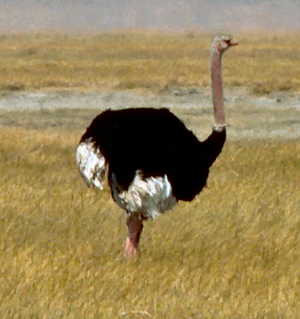Scientific Name: Struthio camelus
Local Names: Jìminaa (Hausa), Nyaluhundo (Bena), Kergyégu (Kanuri),
The feathers of adult males are mostly black with a white tail. Females and young males are greyish-brown and white. The head and neck nearly bare with a thin layer of down. The legs of the ostrich are bare skin and each foot has two toes. Ostriches are 1.8 to 2.8 metres (5 ft 11 in to 9 ft 2 in) tall, weigh up to 140 to 290 pounds and can live up to 45 years.
Ostriches eat mostly plants, roots and seeds, but are known to also eat insects and lizards.
Ostrich prefer open land, semi-desert and true desert. They can run at speeds of up to 45 mph. They use their wings as rudders to help them change direction while running.
Males will fight for harems of two to seven females by slamming their heads into each other. These fights only last a few minutes, but can result in death.
The ostrich is the largest living bird and lays the largest eggs. Eggs are laid in a communal nest that is about 1 to 2 feet deep and 10 feet wide. The dominant female lays her eggs first with the other females adding their eggs later. Extra eggs from the weaker females are discarded first by the dominant female leaving around 20 eggs in the nest to be incubated. The dominant female and male will take turns incubating the eggs. Incubation is 35 to 45 days. The survival rate is very low for ostrich chicks at the rate of one per nest or 5% surviving until adulthood.
A group of ostriches are called a pride or flock of ostrich. They live in small herd that normally contain less than 12 birds.
Hyenas, jackals, various birds of prey, and vultures prey on ostriches. If threatened an ostrich will flatten itself on the ground or run away. Corner an ostrich and it will kick you with its strong legs.
There is no concern for the extinction of ostriches. Ostrich feathers are considered decorative and are used in feather dusters, their skin is used in leather products, and their meat is sold as food.

